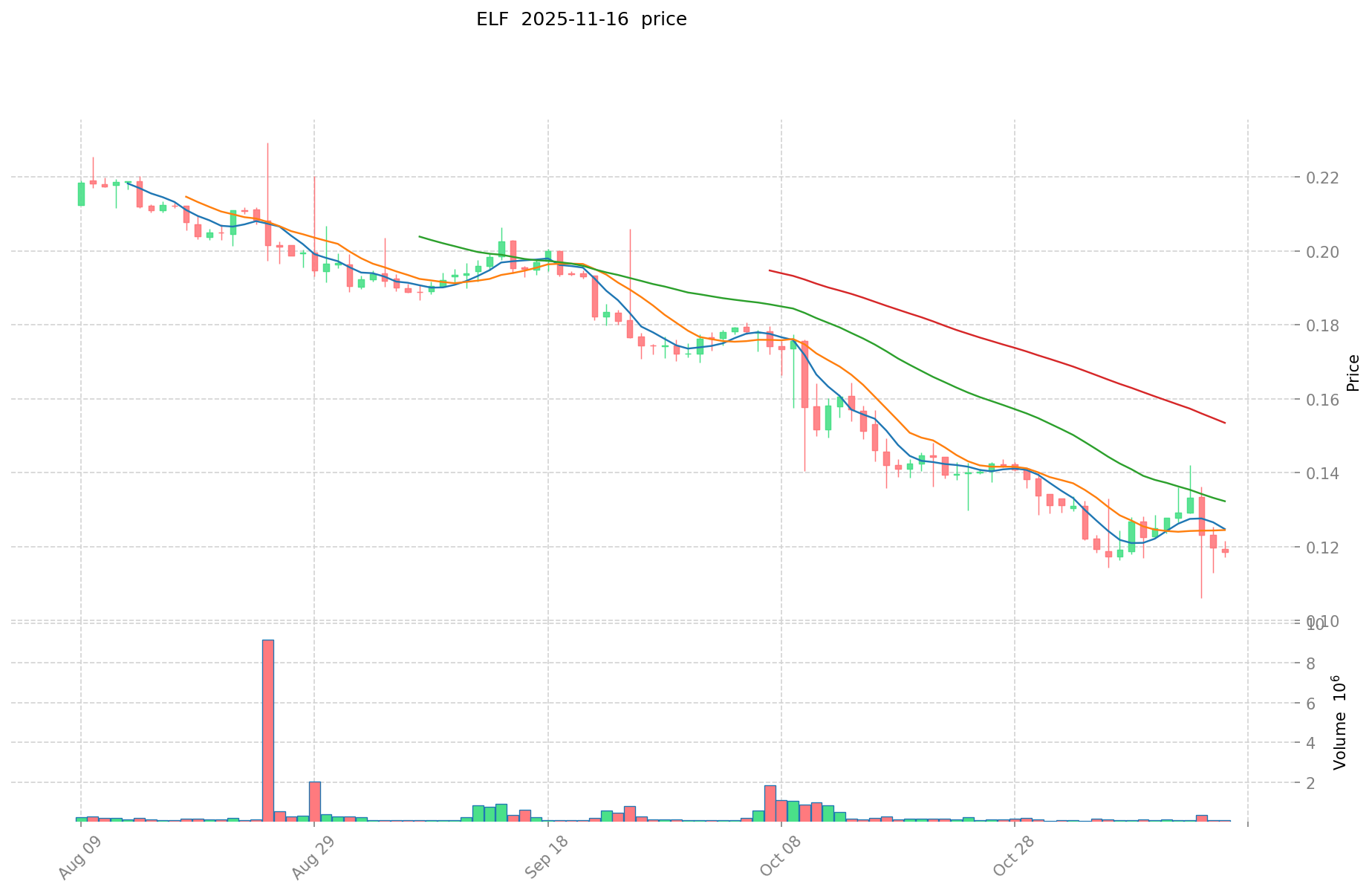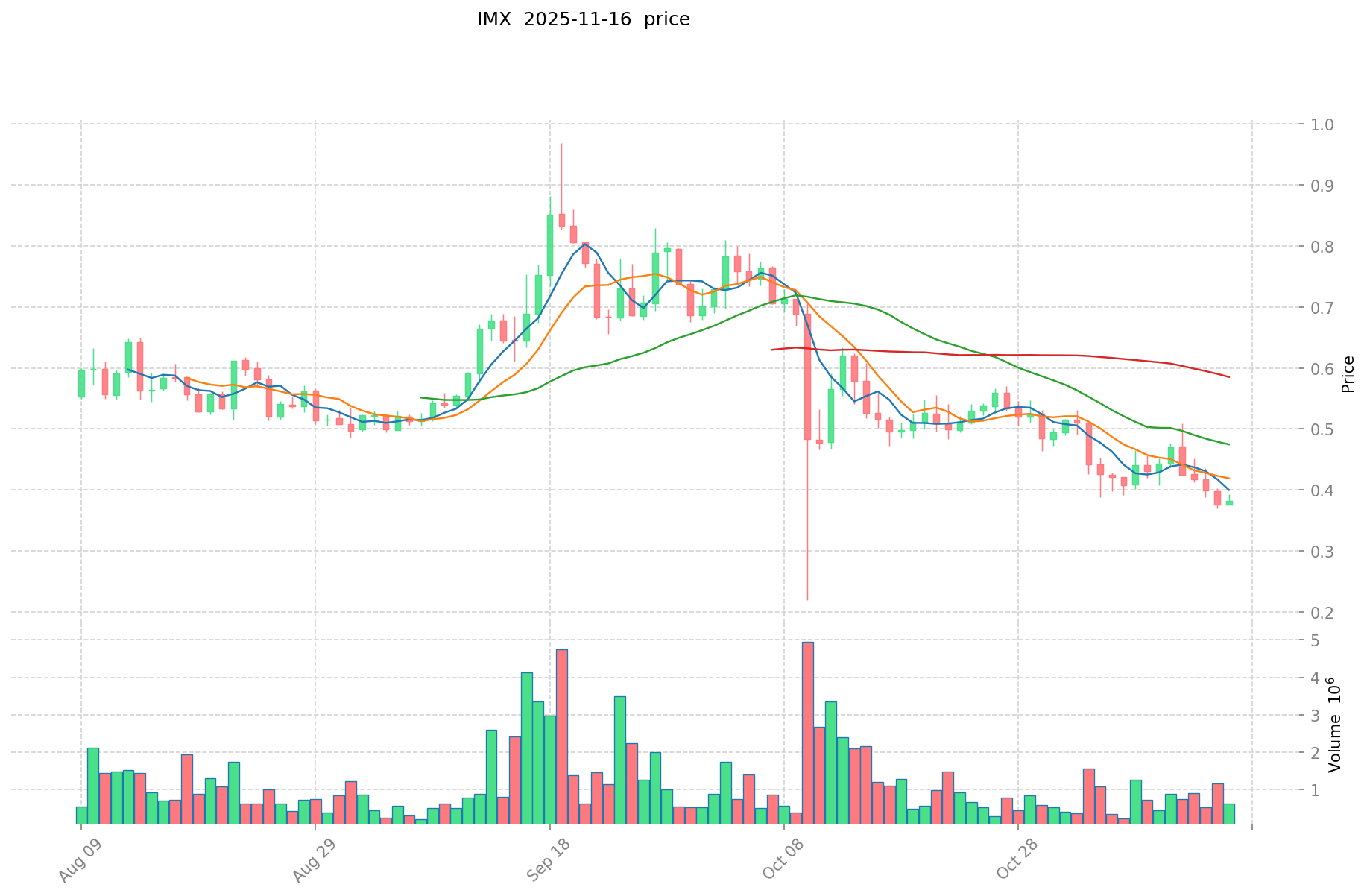ELF vs IMX: A Comparison of Executable File Formats for Embedded Systems
Introduction: ELF vs IMX Investment Comparison
In the cryptocurrency market, the comparison between aelf (ELF) and Immutable (IMX) has been an unavoidable topic for investors. The two not only differ significantly in market cap ranking, application scenarios, and price performance but also represent different positioning in the crypto asset space.
aelf (ELF): Since its launch in 2017, it has gained market recognition for its AI-enhanced Layer 1 blockchain network with advanced integration and modular Layer 2 ZK Rollup technology.
Immutable (IMX): Introduced as a Layer 2 scaling solution for NFTs on Ethereum, offering instant transactions, scalability, and zero gas fees for minting and trading.
This article will provide a comprehensive analysis of the investment value comparison between ELF and IMX, focusing on historical price trends, supply mechanisms, institutional adoption, technological ecosystems, and future predictions, attempting to answer the question most concerning to investors:
"Which is the better buy right now?"
I. Price History Comparison and Current Market Status
ELF (Coin A) and IMX (Coin B) Historical Price Trends
- 2018: ELF reached its all-time high of $2.6 on January 9, 2018.
- 2020: ELF hit its all-time low of $0.03545756 on March 13, 2020.
- 2021: IMX reached its all-time high of $9.52 on November 26, 2021.
- 2025: IMX hit its all-time low of $0.334412 on October 11, 2025.
Comparative analysis: Over the past year, ELF has experienced a significant decline of 67.81% from its previous high, while IMX has seen an even steeper drop of 70.47% from its peak.
Current Market Situation (2025-11-16)
- ELF current price: $0.1227
- IMX current price: $0.3729
- 24-hour trading volume: ELF $24,650.65 vs IMX $224,336.48
- Market Sentiment Index (Fear & Greed Index): 10 (Extreme Fear)
Click to view real-time prices:
- View ELF current price Market Price
- View IMX current price Market Price


II. Core Factors Affecting Investment Value of ELF vs IMX
Supply Mechanisms Comparison (Tokenomics)
- ELF: Fixed total supply of 1 billion tokens with approximately 68% of the total supply currently in circulation.
- IMX: Maximum supply of 2 billion tokens with phased token release schedule spanning over 4 years for ecosystem incentives, development, and project reserves.
- 📌 Historical pattern: Fixed supply models like ELF's tend to create scarcity value over time, while structured release schedules like IMX's can balance growth incentives with market stability.
Institutional Adoption and Market Applications
- Institutional holdings: IMX has secured stronger institutional backing through partnerships with major gaming companies and venture capital support.
- Enterprise adoption: IMX shows wider enterprise adoption through integrations with major gaming platforms (Illuvium, Gods Unchained) and partnerships with GameStop, TikTok, and VeeFriends, while ELF focuses more on business-oriented blockchain solutions.
- Regulatory stance: Both projects operate in regulatory gray areas in many jurisdictions, though IMX's gaming focus may provide clearer regulatory pathways in some markets.
Technical Development and Ecosystem Building
- ELF technical upgrades: Focuses on enterprise-grade Layer 1 blockchain with side-chain architecture and multi-level governance, aiming to optimize for business applications and cross-chain interoperability.
- IMX technical development: Zero-knowledge proof technology enabling gas-free NFT minting and trading, with Layer 2 scaling solution on Ethereum providing high transaction throughput (up to 9,000 TPS).
- Ecosystem comparison: IMX has established a stronger foothold in gaming and NFT ecosystems with deeper integration across multiple platforms, while ELF offers broader enterprise functionality but with less specialized market penetration.
Macroeconomic Factors and Market Cycles
- Inflation performance: Both tokens have shown volatility during inflationary periods, with neither demonstrating consistent inflation-resistant properties.
- Macroeconomic monetary policy: Both tokens are affected by broader crypto market sentiment which correlates with interest rate decisions and dollar strength.
- Geopolitical factors: IMX's gaming focus may provide some insulation from certain cross-border regulatory pressures, while ELF's enterprise focus could be more susceptible to international business climate changes.
III. 2025-2030 Price Prediction: ELF vs IMX
Short-term Prediction (2025)
- ELF: Conservative $0.102 - $0.123 | Optimistic $0.123 - $0.144
- IMX: Conservative $0.217 - $0.374 | Optimistic $0.374 - $0.400
Mid-term Prediction (2027)
- ELF may enter a growth phase, with estimated prices $0.132 - $0.203
- IMX may enter a bullish market, with estimated prices $0.386 - $0.619
- Key drivers: Institutional capital inflow, ETF, ecosystem development
Long-term Prediction (2030)
- ELF: Base scenario $0.228 - $0.267 | Optimistic scenario $0.267 - $0.297
- IMX: Base scenario $0.708 - $0.878 | Optimistic scenario $0.878 - $1.048
Disclaimer: This analysis is for informational purposes only and should not be considered as financial advice. Cryptocurrency markets are highly volatile and unpredictable. Always conduct your own research before making investment decisions.
ELF:
| 年份 | 预测最高价 | 预测平均价格 | 预测最低价 | 涨跌幅 |
|---|---|---|---|---|
| 2025 | 0.144027 | 0.1231 | 0.102173 | 0 |
| 2026 | 0.16561874 | 0.1335635 | 0.100172625 | 8 |
| 2027 | 0.2034439232 | 0.14959112 | 0.1316401856 | 21 |
| 2028 | 0.224177252432 | 0.1765175216 | 0.151805068576 | 43 |
| 2029 | 0.25644465538048 | 0.200347387016 | 0.1101910628588 | 63 |
| 2030 | 0.296914827557712 | 0.22839602119824 | 0.166729095474715 | 86 |
IMX:
| 年份 | 预测最高价 | 预测平均价格 | 预测最低价 | 涨跌幅 |
|---|---|---|---|---|
| 2025 | 0.400073 | 0.3739 | 0.216862 | 0 |
| 2026 | 0.51082218 | 0.3869865 | 0.23993163 | 3 |
| 2027 | 0.6194879892 | 0.44890434 | 0.3860577324 | 20 |
| 2028 | 0.603641665998 | 0.5341961646 | 0.331201622052 | 43 |
| 2029 | 0.84768918379551 | 0.568918915299 | 0.3413513491794 | 52 |
| 2030 | 1.048289993329937 | 0.708304049547255 | 0.651639725583474 | 89 |
IV. Investment Strategy Comparison: ELF vs IMX
Long-term vs Short-term Investment Strategies
- ELF: Suitable for investors focused on enterprise blockchain solutions and cross-chain interoperability
- IMX: Suitable for investors interested in gaming, NFTs, and Layer 2 scaling solutions
Risk Management and Asset Allocation
- Conservative investors: ELF: 30% vs IMX: 70%
- Aggressive investors: ELF: 40% vs IMX: 60%
- Hedging tools: Stablecoin allocation, options, cross-currency portfolios
V. Potential Risk Comparison
Market Risks
- ELF: Lower trading volume may lead to higher volatility and liquidity risks
- IMX: Dependence on gaming and NFT market trends could impact price stability
Technical Risks
- ELF: Scalability, network stability
- IMX: Ethereum network congestion, potential Layer 2 vulnerabilities
Regulatory Risks
- Global regulatory policies may have different impacts on both tokens, with IMX potentially facing less scrutiny due to its focus on gaming and NFTs
VI. Conclusion: Which Is the Better Buy?
📌 Investment Value Summary:
- ELF advantages: Enterprise-grade blockchain solutions, fixed supply model
- IMX advantages: Strong gaming and NFT ecosystem, institutional partnerships, Layer 2 scaling technology
✅ Investment Advice:
- New investors: Consider a higher allocation to IMX due to its stronger ecosystem and institutional backing
- Experienced investors: Balanced approach with a slight tilt towards IMX, while monitoring ELF's enterprise adoption
- Institutional investors: Focus on IMX for its gaming and NFT potential, but consider ELF for diversification in enterprise blockchain solutions
⚠️ Risk Warning: The cryptocurrency market is highly volatile, and this article does not constitute investment advice. None
VII. FAQ
Q1: What are the main differences between ELF and IMX? A: ELF is an AI-enhanced Layer 1 blockchain network focused on enterprise solutions, while IMX is a Layer 2 scaling solution for NFTs on Ethereum, specializing in gaming and digital collectibles.
Q2: Which token has performed better historically? A: IMX reached a higher all-time high of $9.52 in November 2021, compared to ELF's all-time high of $2.6 in January 2018. However, both have seen significant declines since their peaks.
Q3: How do their supply mechanisms differ? A: ELF has a fixed total supply of 1 billion tokens, with about 68% in circulation. IMX has a maximum supply of 2 billion tokens with a phased release schedule over 4 years.
Q4: Which token has stronger institutional adoption? A: IMX has secured stronger institutional backing through partnerships with major gaming companies and venture capital support, while ELF focuses more on business-oriented blockchain solutions.
Q5: What are the key technical features of each token? A: ELF offers an enterprise-grade Layer 1 blockchain with side-chain architecture and multi-level governance. IMX utilizes zero-knowledge proof technology for gas-free NFT minting and trading on Ethereum's Layer 2.
Q6: What are the long-term price predictions for ELF and IMX? A: By 2030, ELF is predicted to reach $0.228 - $0.297, while IMX is estimated to reach $0.708 - $1.048 in the optimistic scenario.
Q7: Which token is considered a better buy for different types of investors? A: New investors might consider a higher allocation to IMX due to its stronger ecosystem and institutional backing. Experienced investors could take a balanced approach with a slight tilt towards IMX, while institutional investors might focus on IMX for gaming and NFT potential but consider ELF for diversification in enterprise blockchain solutions.
Share
Content